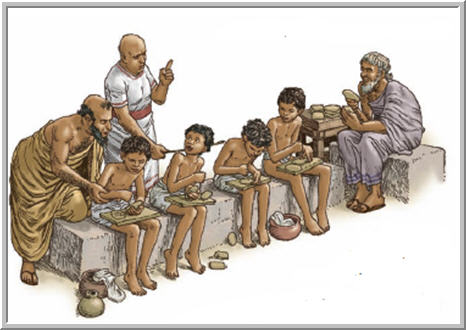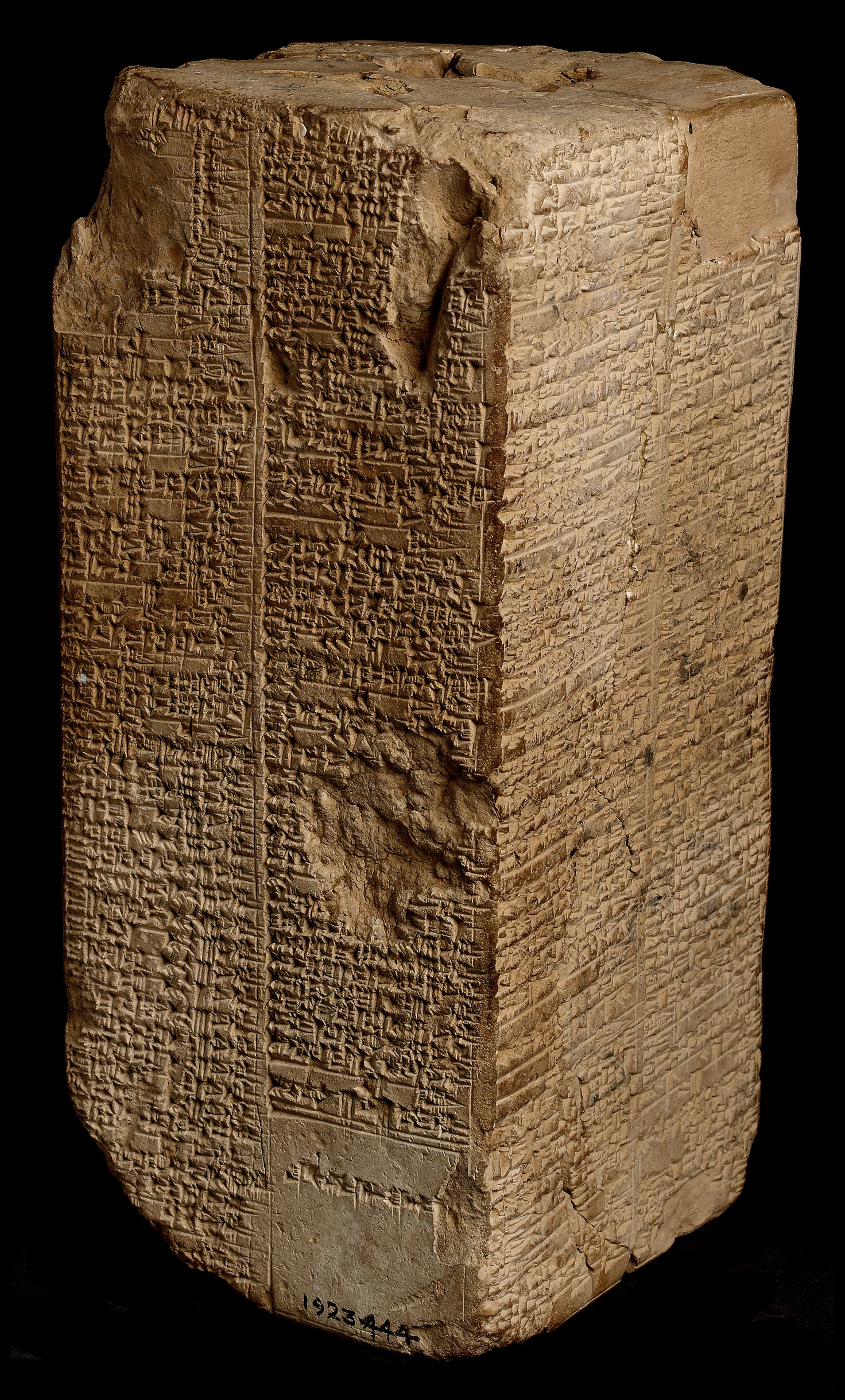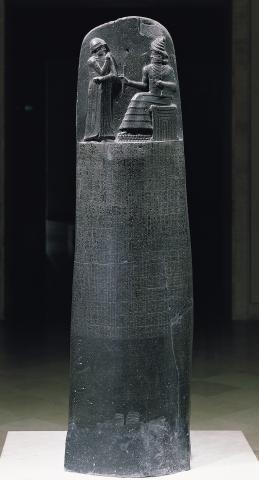- Scribes. Scribing with their reed styli. (Source)
Before writing
Around 3500 B.C., just before the birth of writing, Sumerians had already been maintaining a civilization for thousands of years, complete with farming, temples, and all kinds of commerce, all of which required record keeping.
But how do you keep records without writing? Well, not very practically. Before writing, Sumerians had a system to record their business transactions; it involved tokens made out of clay and a clay bubble to hold the tokens, which they baked into the bubble, rendering the tokens, well, completely pointless. The owner of the token-stuffed bulla (Latin for “bubble”) would’ve made impressions of the tokens on the outside before baking them in, of course, but, you know, that made the tokens even more pointless. (Source)

-
Not practical. A clay bulla and the tokens inside it. (Source)
Luckily, someone in 3500 B.C. decided there was a better way to keep records, one that was quicker, more convenient, and undoubtedly one that was easier to file than a bunch of clay balls!

- Pictographs. Cuneiform went through a series of innovations that turned it into cool-looking, abstract symbols. (Source)
And so writing was born, bringing with it the demand for those who could do it.
Who could?
In 2000 B.C., scribes were some of the most educated people in the world. Along with reading and writing cuneiform, scribes eventually evolved to have chops in math or science or business or literature.
If you could read and write in ancient Mesopotamia, you had a good life, and chances were pretty high you were born into that good life. In fact, some 70% of the scribes we know by name were the sons of society’s elite, including royalty. (Source)
This isn’t to say status was the requirement to become a scribe, but rather the usual source of the requirement: money.
The son of a merchant had as much a chance at becoming a scribe as the son of a king. Even more socially progressive, it eventually became that the daughter of a king, had as much chance of becoming a scribe as her male counterpart. (It is only appropriate, since Sumerians credited the goddess Nisaba with the invention of writing!)
How could they?

- A day at school. An illustration of boys studying to be scribes, the future elite of society. (Source)
Along with money, becoming a scribe took time and hard work.
It’s important to keep in mind that cuneiform was very difficult, even for those who used it practically.
“The scribe did not so much read a line of text as translate it,” wrote Jerald Starr on his website. A scribe had to learn business, math, science, and literature in order for his/her basic literacy skills to even matter. In other words, scribes had to know the context of what they were reading in order to read it, pretty much on a jargon level. The reason for this is because cuneiform, a script used to record more than one language, was a phonetic one—one syllable could make up any number of words, with any number of definitions, depending on whether you were writing in Sumerian or some other Mesopotamian language. (Source)
Boys were sent to an e-dubba, a tablet house where they would spend years learning to read and write the cuneiform script and the subjects they would write about. When they graduated, they became dubsars, tablet writers.
That schooling was no cakewalk for the student, nor was it for his parents. Aside from what I am going to take the liberty of calling tuition, a future scribe’s father also had to factor in the expense of keeping his son’s schoolmaster happy, who expected to be wined and dined in order to go a little easy on a pupil. The son, in the meantime, had to climb up a hierarchy within an e-dubba. You can read more about what these tablet houses were like here and here.
Of course, writing didn’t include women as soon as it was invented. It took a few years for women to show up in records as scribes. According to Radner and Robson, the earliest record of a woman scribe dates to the Akkad period (ca. 2350 – 2150 B.C.). (Source)
Although Karen Radner and Eleanor Robson wrote in their book, The Oxford Handbook of Cuneiform Culture, “The profession of scribe is much better attested for men than for women,” there are things we do know about how women scribes came to be. In her book Daily Life in Ancient Mesopotamia, Karen Rhea Nemet-Nejat wrote that women scribes were the daughters of the elite, some the daughters of scribes. Nemet-Nejat also points out that there were women scribes who were slaves: “Slaves with scribal skills were sometimes given to princesses as part of their dowries.” (Source)
As far as how those women scribes got their chops, priestesses were taught at the temples they served, while those not taking the religious path were taught at home.
What did scribes write?

- Sumerian King List. A scribe was first and foremost a recorder of history. (Source)
For the first thousand years or so after writing was invented, everything written down was of an administrative nature. “Most people will therefore be disappointed to learn that writing was invented for the simple purpose of conducting business transactions, to record the exchange of merchandise,” wrote Starr.
Even after Sumerians branched out to recording more subjective subjects, 97% of what they recorded were things like receipts, ledgers, inventories, contracts, nothing inherently interesting or telling about the human condition. They were practical people, those Sumerians.
This brings us to what scribes could do with their skills, subjectively or not.
“…It’s unlikely that any scribe ever went hungry for lack of paying work,” wrote Starr.
And it’s easy to see why the sky was the limit for a man who graduated from a tablet house. If he came from a family of merchants, he kept records for the business; if he worked in a temple, he recorded offerings for the gods. Heck, e-dubbas needed teachers, and given that e-dubbas were focused on producing bureaucratic officials, the king, whether literate or not, needed a scribe. The king’s court was like Google, where the best minds wanted to end up.

-
Code of Hammurabi stele. This was some commission for one special scribe. (Source)
A scribe didn’t even have to be a full-time scribe to reap the benefits of his skills. He could set up shop in the middle of the town square and write letters for his illiterate neighbors and never go hungry like most people did in the ancient world.
In the Old Babylonian City of Sippar women recorded the transactions of members of the cloister, the city’s financial institution. What we might consider HR records from Sippar (and Mari too) show that a good number of those women were slaves. Women scribes are also known to have written songs and lullabies for the royalty, along with laments. According to Nemet-Nejat, royal women of the Ur III Dynasty (2114-2004 B.C.) wrote songs to praise their kings.
Their Bylines

-
A tablet bearing the world’s oldest love poem that depicts the sacred marriage between Inana and Dumuzi. Could a woman’s hand have written this tablet? (Source)
As I mentioned in the last section, only some scribes got to let themselves be known directly through their work to anyone other than their employer. I also mentioned there were female slave scribes whose social status gave them less pay than their colleagues.
Obviously, there was a hierarchy within the elite. The son of a merchant has as much chance to become a dubsar as the son of a king, sure, but once those two are out in the real world, their social differences surely resurface. Moreover, without a signature, it gets hard to know anything about the scribe, even their gender.
Nemet-Nejat wrote that we see signatures on some tablets as early as 2600 B.C. Now, perhaps due to the verbal storytelling tradition, literary works, like the Epic of Gilgamesh, were set to stone anonymously, but that did not mean the one who set it to stone couldn’t be held accountable for mistakes–a list of scribes who wrote and edited well-known works was found at Nineveh.
For scribes who got to sign their names, as their heads inflated with importance, they took to including their lineage, traveling back as far as their earliest ancestors (helping us determine their social status thousands of years later!). Some took their title up a notch, adding “astrologer” to scribe, for example, or were probably asked to make it clear they were a “junior scribe.” Some just showed up in their own narrative, but they were very special (I will talk more about this in the next section). (Source)
The most profound examples, I feel, which demonstrate just how big a gap there is between a royal/noble scribe versus anyone else, lies in one of the products of scribes: the seal. Loftier scribes made seals, autograph stamps, if you will. Seals were cylinders made of stone, carved with impressions pertaining to their owner, often bearing divine scenes that tell a lot about his/her social status. It is through these scenes we get an idea of just how revered a literate royal or noble was.

- The seal of Arad-Nanna, a scribe of very high status. (Source)
On the cylinder seal of Arad-Nanna, a high official and possibly of royal blood, we see him having audience with the king, with a goddess in tow. According to Starr, the difference in body language of Arad-Nanna and the goddess accompanying him is one of great significance. “Arad-Nanna doesn’t hold his hands in the ‘reverence’ position,” Starr points out. “The scene is almost relaxed and familiar, as between two near-equals. This suggests he is a member of the royal family. The goddess who accompanies Arad-Nanna is not a minor goddess … The multiple horns on her helmet indicates that she is a major goddess. Significantly, she has her hands held up in reverence to the king, whereas Arad-Nanna does not.” (Source)
Even goddesses took the backseat to scribes of noble or royal birth, and it is clear that it was those individuals whom the king employed in his courts to be his officials and recorders of his feats.
As for knowing the gender of the writer, often the only thing we have to go on to tell us a woman is the author of something is the presence of a feminine touch in the writing. Starr sensed that in a tablet he translated recently. Radner and Robson also wrote about how the Ur III and Old Babylonian periods were seasoned with Sumerian writings about the goddess Inana and the god Dumuzi being in love, leading scholar Jerrold Cooper to believe that the authors of some of those compositions were women, simply because of “feminine sensibility and a female approach to sexuality.” (Source)
And this brings us to an important distinction, a case of semantics.
When a scribe is an author

-
Tablet #36. A mystery, far from administrative. (Source)
The Merriam-Webster Dictionary defines the word “Author” as “a person who starts or creates something (such as a plan or idea).” Nemet-Nejat wrote that when a work is by a single author, it shows “uniqueness in language, subject matter, and artistic development.” Ultimately, the two sources agree that an author is more than just a recorder. (Source)
On his blog, Starr has written about Tablet #36. It is a tablet that embodies all of what Nemet-Nejat (indirectly) says makes it the work of a unique author. Tablet #36 was a mystery until Starr translated it and found it was an encoded political satire, a work written by one, no ordinary scribe: “…the language of [Tablet #36] is too sophisticated to have been written by someone who was only casually acquainted with the complexities of narrative cuneiform writing,” Starr wrote. “There can be little doubt that the story of [Tablet #36] was written by a full-time ‘wordsmith.'” You can read about this tablet, the content of which Starr titled “The Great Fatted Bull,” along with Starr’s musings about its enigmatic author here.
Starr points out that the author of Tablet #36 was most probably not a full-time scribe, just someone who could write and had the luxury of thinking for himself, along with the time to create a code for his dangerous thoughts. This guy was a completely different animal from, say, Arad-Nanna, who was too drunk on rubbing elbows with the king to criticize him.

-
Enheduanna. An author. (Source)
Enheduanna, daughter of Sargon of Akkad and the Shakespeare of Sumerian literature, was also a different animal. She wrote poems and laments that included a personal dimension, something I mentioned earlier was reserved for a special few allowed to include themselves in the human experience, and a rare occurrence in much of the ancient world’s writings. Enheduanna was no run-of-the-mill scribe who only wrote generic praise-filled songs to the king, no. She wrote about her expulsion during her brother’s reign, a criticism that wouldn’t have let her writing career span some forty years, as she wouldn’t have been left to live it.
Radner and Robson wrote that being an author in a world of scribes was a feat for a king, and certainly one for a woman of high birth:
“The essential point is that in antiquity unusual men, such as rulers, or a woman such as Enheduana, exceptional because of her high birth and religious duties, could equally be regarded as authors.” (Source)
Contemporaries of their own legacy
It is safe to say that the first scribes were contemporaries of their own lasting legacy, and the status they enjoyed was appropriate, whether they recorded sheep sales or wrote in code…
“Without scribes, letters would not have been written or read, royal monuments would not have been carved with cuneiform, and stories would have been told and then forgotten.” (Source)
Imagine what a world this would’ve been without scribes.
Sources and further reading:
The Sumerian invention of writing http://sumerianshakespeare.com/30301.html
Nisaba http://www.goddessschool.com/projects/artesia/fpl1nisaba.html
Daily Life in Ancient Mesopotamia (Women scribes) https://books.google.com/books?id=lbmXsaTGNKUC&pg=PA150&lpg=PA150&dq=women+mesopotamia+scribes&source=bl&ots=dt2I9mGPqk&sig=qJ_MkVscUVs9hUvb_D28fKDB87I&hl=en&sa=X&ei=WGBJVes0hKOwBfDYgdAB&ved=0CCUQ6AEwAQ#v=onepage&q=women%20mesopotamia%20scribes&f=false
Daily Life in Ancient Mesopotamia (Scribe signatures) https://books.google.com/books?id=lbmXsaTGNKUC&pg=PA64&lpg=PA64&dq=how+scribes+signed+their+names+on+mesopotamian+tablets&source=bl&ots=dt2L3mNWpq&sig=6LCEsL7O0Y56BNxD8KiYP0D-CPk&hl=en&sa=X&ei=Zx1uVcPFIIanyQS68YP4Cg&ved=0CCUQ6AEwAQ#v=onepage&q=how%20scribes%20signed%20their%20names%20on%20mesopotamian%20tablets&f=false
Scribal social ranking in Sumerian Society http://sumerianshakespeare.com/34101/68901.html
Family life in Ancient Sumeria http://stravaganzastravaganza.blogspot.com/2011/12/sumerian-family-life.html
Women As Scribes Throughout History http://exploringfeminisms.com/2011/06/27/women-as-scribes-throughout-history-originally-written-fall-of-2010/
An introduction to the princess wife http://sumerianshakespeare.com/533701/index.html
The Oxford Handbook of Cuneiform Culture https://books.google.com/books?id=i4jBn3cThwgC&pg=PA99&lpg=PA99&dq=sippar+records+of+women+scribes&source=bl&ots=jpjBY4p0pZ&sig=Hbeu85_RO6zV86PKQYti3cy90bY&hl=en&sa=X&ei=neeJVc2MFsHasQXR7YL4Cg&ved=0CCgQ6AEwAg#v=onepage&q=sippar%20records%20of%20women%20scribes&f=false
Tablet #36 https://allmesopotamia.wordpress.com/2011/11/01/tablet-36-by-sumerian-shakespeare/
Tablet #36 (Sumerian Shakespeare) http://sumerianshakespeare.com/6801.html
The Scribe http://sumerianshakespeare.com/34101/index.html
Writing Page http://www.mesopotamia.co.uk/writing/home_set.html




